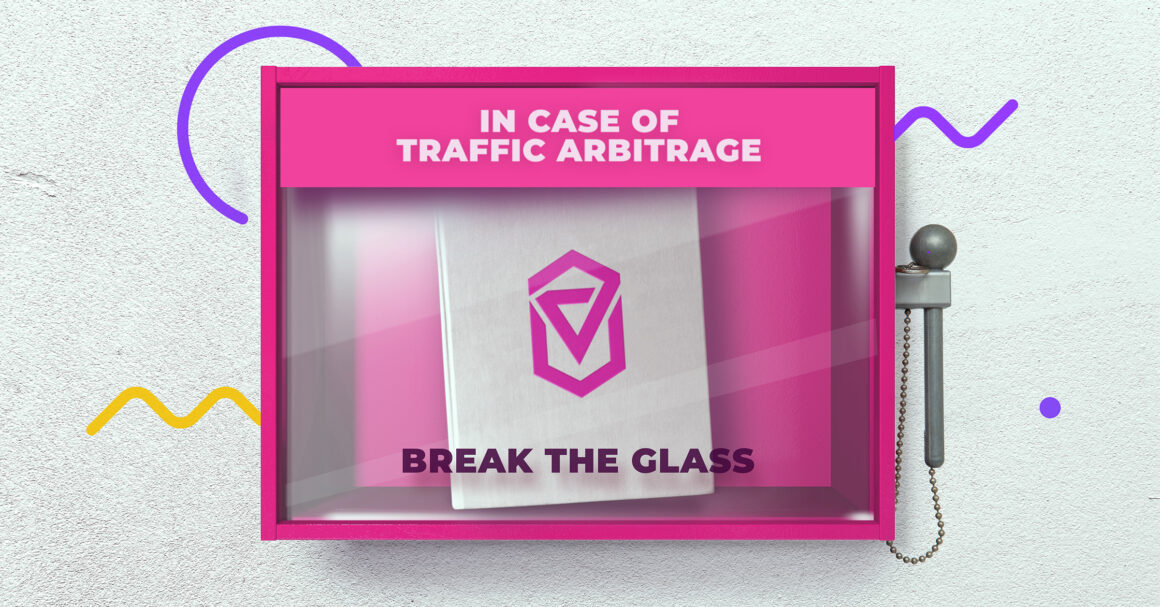Traffic arbitrage is a fascinating and dynamic example of how people can take an idea, expand it, and take it to another direction. Running digital ads is a simple concept that lets you learn a lot about your traffic.
If you feel you know a lot and want to try something new, if you already heard about traffic arbitrage but need more details in order to run it efficiently than this article is for you.
How Does Traffic Arbitrage Work?
The typical marketing scenario looks like this:
- An ad is displayed to an audience outlined in a traffic source’s setup.
- A click on this ad sends a visitor to a landing page, and later to the offer page – provided that this visitor demonstrates an interest in it.
- A tracker records all these events.
Can you see the flaw in this scenario?
Sure you do, you are a smart marketer. After all, you are reading this article!
But let’s write this clearly for your not-so-wise friend that is reading this text with you.
The flaw is that you can’t really tell what your audience is really interested in. You assume that some general criteria are enough to define their intent:
- People that have Samsung Galaxy phones want cases for their phones, right? That sounds reasonable.
- iPhone users should be interested in crypto offers, right? Why not others? Why them? It is more of a gut feeling.
- Hmm, who should be the target for house security offers? Gaming affiliate programs?
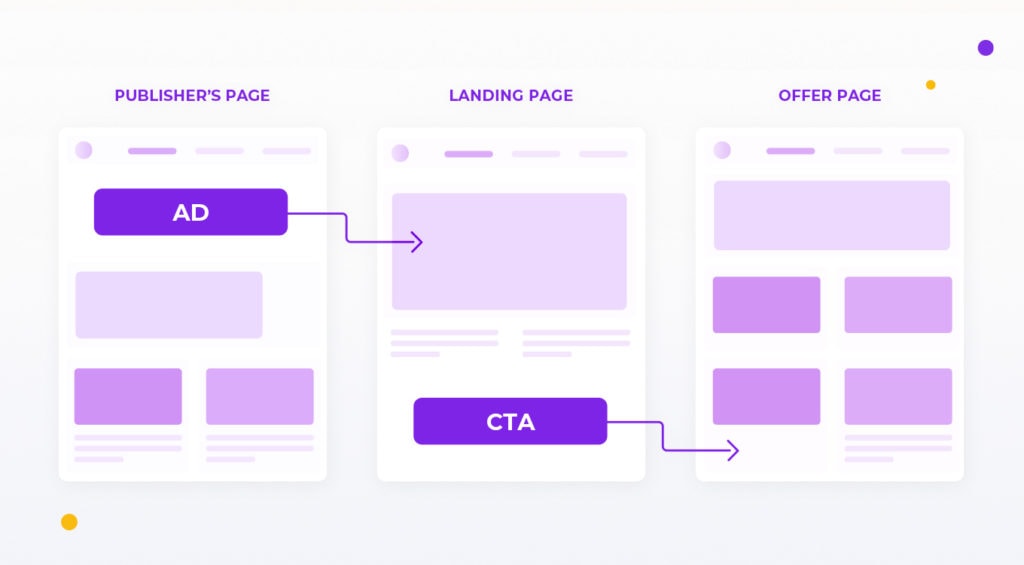
Your own traffic or the traffic you bought in a traffic source is qualified only once: by an ad that determines general intent.
What traffic arbitrage brings you is the option to double qualify visitors by granting you access to the world’s best search feed.
Here’s how it works:
- A visitor clicks a relevant ad. This could be a native ad but also banner or other ad type. Let’s assume that this ad says ‘Time travel!’. This is the first qualification.
- The visitor is then directed to a special landing page that contains search results related to the ad. A visitor sees search queries such as ‘Cheap time travel’, ‘Best time travel gear’, ‘Easy fix to grandfather paradox’. Clicking on one of these queries is the second qualification.
- An ad tracker records all these steps until the conversion occurs.
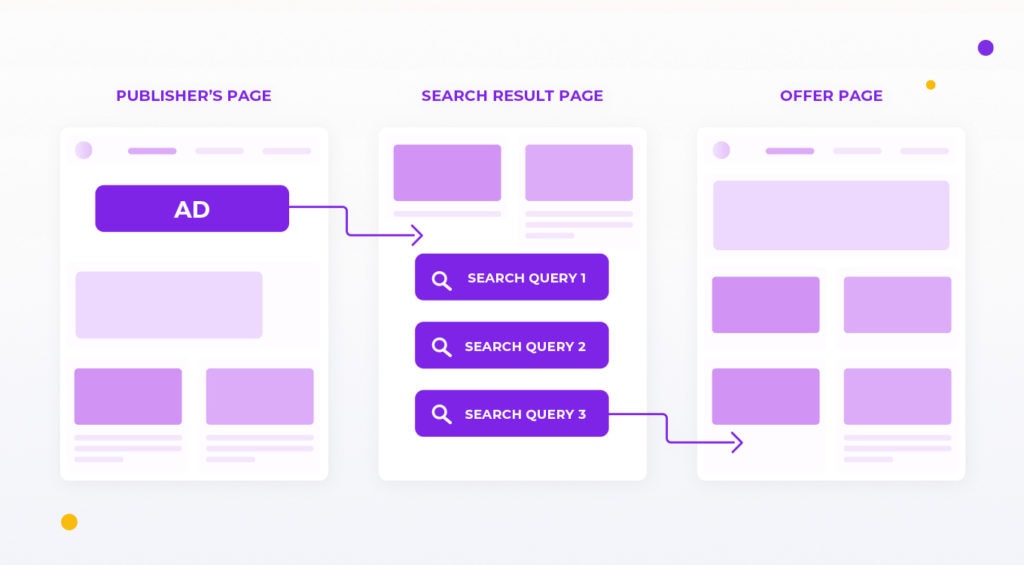
Can you see the brilliance? I know you can but let me explain it clearly for your dumber friend that is overlooking this article.
Because of this double qualification, a final offer is much closer to the visitor’s interest, and therefore, has much higher chances of converting.
Traffic arbitrage is about reselling traffic. You still deal with two sides of the equation: a party that you get traffic from (ad network) and a party where you sell and redirect traffic to (feed providers). Same as in any paid advertising scenario.
The difference is that your traffic doesn’t go immediately to an offer. Instead, it goes to the search engine result page (SERP) that then takes visitors to the final offers.
From the perspective of feed providers – you are the traffic source.
Where’s the money for you?
Your revenue is made from the small differences between the prices of purchased traffic and prices of sold traffic.
Yes, small differences. Traffic arbitrage is a big-numbers game. To be profitable, you need to run some serious traffic volumes to turn these small margins into serious revenue.
Read below to learn more.
Who participates in traffic arbitrage?
The following persobas are a part of a traffic arbitrage funnel.
- Arbitrageour (arbitrage marketer). This is you, connecting all stakeholders with a traffic arbitrage campaign. Your role is to make everyone happy – and earn some money along the way.
- Ad network. This is where you will be getting traffic from. This may be a standard CPA network, social media platform, search engine, or any other place where you can get money from in exchange for money.
- Feed provider. This is where you will be directing traffic to. Feed providers are a bit like affiliate networks in standard affiliate marketing campaigns. But instead of presenting a single offer, they display a SERP-like page with search queries related to the original ad in the ad network. Feed providers are a general term – there are usually run by affiliate programs that act as feed providers.
How to choose the best affiliate program for traffic arbitrage?
Choosing a destination for your arbitrage traffic is an important decision. After all, your earnings depend on that.
There are the following aspects that you should take into consideration when choosing the best affiliate program for your traffic arbitrage campaigns:
- Vertical: make sure that a given program operates in a vertical you want to advertise in.
- Reputation: Since you are working on behalf of the offer owner, you need to make sure that this offer is reputable. Check Affiliate program’s opinions and testimonials before joining.
- Keyword matching. Good affiliate program needs to sport an awesome keyword matching mechanism to ensure that the offers it present are related to the original search term.
- Payout conditions. Affiliate programs usually support monthly payouts but if cashflow is a problem, go with a program with weekly or at least bi-monthly payouts.
How to find traffic arbitrage sites?
Finding traffic arbitrage sites involves a strategic approach to identifying platforms that serve as intermediaries in the online advertising ecosystem.
- Firstly, scouring popular advertising networks and platforms such as Google AdSense, Taboola, and Outbrain can reveal potential candidates. These platforms often connect publishers with advertisers and offer opportunities for traffic arbitrage.
- Monitoring online forums and communities related to digital marketing, affiliate marketing, and SEO can provide valuable insights and recommendations from experienced practitioners.
- Keep an eye on websites that frequently display ads from various niches, as these could be actively engaged in traffic arbitrage.
- Analyzing website traffic sources, such as using tools like SimilarWeb or Alexa, can further help identify sites that leverage arbitrage to capitalize on the difference between ad revenue and traffic acquisition costs.
It’s essential to stay updated on industry trends and continuously refine search criteria to discover new traffic arbitrage opportunities.
How much can you earn in traffic arbitrage?
It is difficult to precisely estimate how much you can earn with traffic arbitrage. You don’t earn much on a single click, that’s for sure. But when you work on a larger scale, it is only important to surpass the breakeven point and you will start earning some serious money. Even if you earn only ten cents on each click, it will turn into $100 daily with 1,000 clicks.
You need to have cash reserves to buy large volumes of traffic that you can then monetize with traffic arbitrage. It is not profitable to run traffic arbitrage campaigns on a lower scale.
Requirements of running traffic arbitrage
There are two main requirements that you should fulfill before you jump headfirst into arbitrage:
- Ad spend on the ad network side (where you will get traffic from) – You should spend at least 3 – 4 figures a day to be approved by feed providers.
- High quality traffic – Learn the requirements of feed providers regarding the traffic they accept. Sending low quality traffic (non-converting, full of bots) may result in account suspension. Feed providers have tools to check the traffic quality (TQ)
Types of traffic arbitrage
Depending on the traffic type you send, you can distinguish several traffic arbitrage types:
Search to search
In this scenario, you purchase traffic connected with a cheaper keyword and then you send it to a feed provider for the same or very similar keyword that is slightly more expensive.
Display to search
You purchase banner traffic and then send it to related search results. As display traffic is generally considered to be cheaper, this is a great option to start, as it is financially safer.
Native to search
The goal of this type is to buy cheap traffic from a native platform and send it to a search result page.
Social to search
Traffic bought on social platforms is sent to a search result page. Like with display to search type, social traffic is usually a bit cheaper, so making a profit in this case should be a little bit easier.
Ad networks
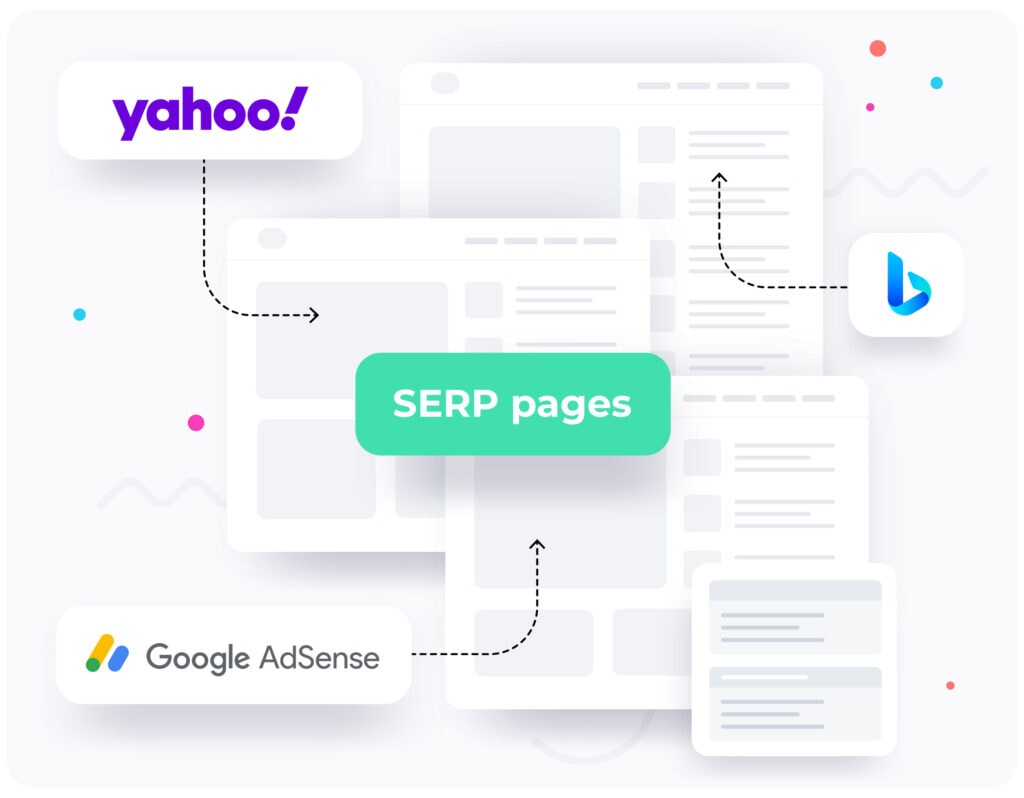
You don’t need a special network, you just need any platform that sells good quality traffic. Here are some examples that work well for many our customers:
- Native: Outbrain, Taboola, Yahoo!, Tonic, Revcontent
- Social: Facebook, Instagram
- Search & Display: Google Ads
- Push: Zeropark (PPC model)
Feed providers
Feed providers are the ones that generate search engine result pages that then link to concrete offers.
These offers are, obviously, related to the originally searched keyword or displayed ad. The search queries are usually more specific versions of the original ad. For example, if the original ad displayed via an ad network advertised ‘space suits’, the search SERP page displays results such as:
- ‘Space suit for women’
- ‘Space suit helmet’
- ‘Oxygen tank’
This double-qualifies visitors and allows them to reach the most fitting offer. It does wonders for conversion rates.
Popular feed providers:
- Google AdSense
- Yahoo
- Bing
- System 1
- CBS Interactive
- Sedo
- Tonic
- Domain Active
Feed providers are very strict when it comes to traffic quality. They also have a set of their own requirements which you must fulfill. Otherwise, you risk getting banned.
Traffic quality
There are several factors that make up good quality traffic:
- Convertibility
- Stability
- Human origin
Make sure that you check all of these boxes before you start sending them traffic.
Funnel types
Let’s talk more about how traffic arbitrage works by showing you the two different funnel types that are typically used with arbitrage:
- 1 Click flow: Ad -> SERP page
- 2 Click flow: Ad -> prelander (so-called parked domain) -> SERP page
The important thing to know at this point is that SERP pages (feeds) cannot be edited. More on that later.
How to Make Traffic Arbitrage Profitable
The quick answer is: know when you struck a balance between cost and revenue. Because that’s what traffic arbitrage is all about. There are no delayed benefits like with lead generation campaigns, no other goals, like with brand awareness marketing.
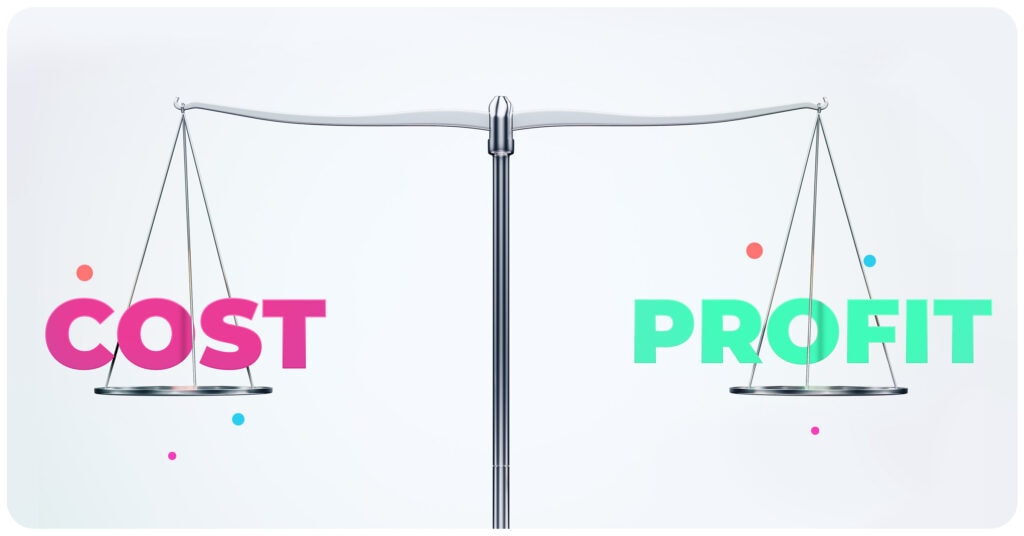
With the cost of getting a click being so close to the money you get from each click, accurate tracking is everything. And there are no better options for tracking traffic arbitrage than Voluum.
Funnel setup
Voluum supports two tracking methods: direct and redirect. While the direct method has a lot of benefits, unfortunately, most feeds and prelanders cannot be edited. Therefore there is no possibility to paste any Voluum direct tracking script nor link into the HTML of the page, which is why we recommend adding feeds (in case of 1 Click Flow), and a prelander (in case of 2 Click Flow, eg. Tonic) as Offer elements.
Each time a feed with ads is loaded within the Voluum campaign, Voluum will record a visit.
Keywords
You need to pass information about keywords being clicked from an ad network to Voluum and matched with a custom variable. You can then pass this information to the feed provider by appending the custom variable to the offer URL.
Tracking clicks on feeds
Voluum can track such clicks as conversions. Conversions can be tracked either with a Conversion tracking pixel or postback URL.
Again, lack of option to edit feeds prevents you from using the Conversion tracking pixel. Feed providers which support a postback URL solution can relay click information back to Voluum. You can track clicks as conversions by creating a custom conversion and adding the ‘et’ parameter to the postback URL (et=click).
It may take between 24 – 36 hours for a feed provider to register the click and send the click information as a conversion to Voluum. You can use the Conversions upload feature to manually input information about conversions with revenue data.
Tracking costs
Cost information is passed from a traffic source, and you can get it in Voluum with the cost token added to the campaign URL (traffic source has to support it) or with an API integration through the Voluum Automizer module.
Alternatively, you can set a fixed cost for each click on an ad when creating a campaign in Voluum. Refer to this article for more information on Tracking Cost.
Voluum integration with TONIC.
TONIC is one of the most popular traffic monetization platforms that uses search feeds to direct visitors to offers. Voluum now supports API integration with TONIC. that is capable of passing ‘final revenue’ event data to Voluum automatically.
Before that, you would have to upload conversions manually for this event type. Now it’s only a matter of a couple of clicks. Other event types can be passed with postbacks and the setup for all other events can be found in our knowledge base.
The integration removes the biggest obstacle that was standing between you and one of the best traffic arbitrage search feed provider on the market. Enjoy their premium feeds and Voluum’s tracking capabilities with ease!
Good practices
Lastly, let’s talk about some good practices that, if followed, should ensure that your campaigns will run smoothly and without any hiccups.
Test. Secure a budget for testing in the initial phase in order to identify the most converting traffic. Only after you have this can you consider sending it to your best feed providers.
Keep traffic clean. If you want to make money with the feed, and not lose it, make sure to filter out low-quality traffic.
Adult traffic. Be very careful when promoting adult content with arbitrage. Mainstream arbitrage feeds can be very strict and as you may know, adult traffic is not a piece of cake. It is possible to run adult traffic with arbitrage but you really have to know what you are doing. It’s a lot like treading on thin ice – one false move and everything goes to hell.
Verticals. Choose the right evergreen or seasonal verticals. Seasonal offers have high conversion rates only during specific periods of the year while evergreens should convert all year round.
Compliance. In order to run successful campaigns and enjoy high profits from traffic monetization, you need to comply with the policies of the platforms you use: feed providers and ad networks (traffic sources).
This rule applies especially to Google, Bing, and Yahoo, whose policies are very restrictive, so double-check if the traffic you resell is always compliant with their requirements.
Campaigns with Facebook, Microsoft Bing, and Google Ads require a direct transition from ad to campaign funnel, which is why a direct tracking script needs to be implemented into the HTML of the first destination page. If you use a feed from an arbitrage platform which doesn’t allow you to edit the source code, running campaigns with these mentioned platforms may not be possible.
Traffic quality. Companies like Yahoo!, Google, and Bing have set benchmarks for arbitraged traffic TQ scores. TQ has been implemented for feed-owners to see the quality of traffic provided to them. If the score is too low you can lose the feed. High-quality traffic depends on the combination of the best niche, geo, and set of keywords.
Popular Niches and GEOs For Traffic Arbitrage
Some popular niches for arbitrage include:
- Culture and news feed
- Product comparison
- Parenting
- Education, student loans
- Finance, refinance credit cards
- Medicines, Nutra
- Website building
- Insurance
- Antivirus
- Law guidance
The typically good GEOs are:
- United States (US) – Tier 1
- France (FR) – Tier 1
- Italy (IT) – Tier 1
- Germany (DE) – Tier 1
- United Kingdom (GB) – Tier 1
- Spain (ES) – Tier 2
- Belgium (BE) – Tier 2
- Netherlands (NL) – Tier 2
- Peru (PE) – Tier 3
As with other digital marketing types, Tier 1 countries (so rich countries where the Internet appeared first) usually are harder, as the competition between advertisers is fiercer and Internet users have seen all tricks already – but they also provide higher rewards.
Tier 2 countries are often the sweet spot of advertising, the healthy balance of not too big competition and reasonable payouts. Tier 3 countries offer the cheapest traffic – but traffic quality may be an issue.
Traffic Arbitrage Is Not For Everybody But May Be For You
If you haven’t tried it, you will never know. As long as you meet the entrance criteria of running traffic in some serious volumes, you can try to dip your fingers in traffic arbitrage.
Although low margins sound like a turnoff, remember that due to double qualification (so showing offers that are more precisely targeted thanks to the SERP page) the conversion rates are much higher. Circling back to our example, a person searching for a space suit helmet should be more inclined to click the search query on the feed provider’s page that says exactly that, instead of following a more general ‘space suit’ ad.
If you decide to try arbitrage for yourself, especially if you want to try TONIC., make sure that you have your trusty ad tracker ready.

